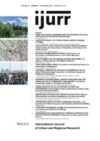This article examines the repositioning of racialized credit risk produced by new regulatory practices that have emerged in the neoliberal era. As increasingly volatile financial markets have periodically threatened the ability of the banking sector to supply credit, US regulators have adopted more aggressive roles to isolate ‘troubled assets’ and restore the norms of risk management. Revisiting the emergence of the US subprime mortgage market in the early 1990s, I use this framework to assess a critical question for urban political economy: how could decades of racial exclusion from US credit markets have been transformed so quickly and decisively into the exploitation of minority borrowers within the subprime market? The article identifies a series of regulatory practices associated with the management of the late‐1980s banking crisis, arguing their distinctive orientation towards the circulation of risk created a new legal and market space for high‐risk loans. I then examine the migration of those emergency risk practices into the institutional venues that shaped the subprime market and that differentially exposed minority borrowers to heightened rent‐seeking. The results suggest new avenues for urban political economy emerging from a broader conceptualization of state relationships to financial risk.
Details
Written by:
PHILIP ASHTON
Digital Object Identifier (DOI)
10.1111/j.1468-2427.2011.01077.x
About DOI
Read full article as PDF
Read full article as HTML
See the references for this article
